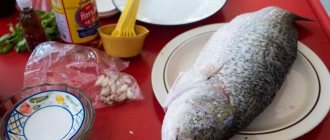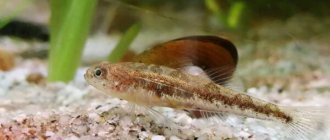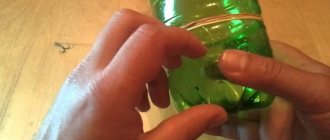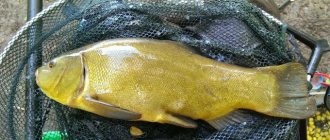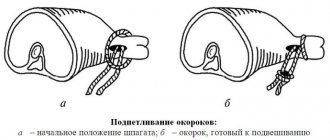Yuri 09/21/2020 326
Since the appearance of pheromone-based bait in fishing stores, there has been ongoing debate among fishermen about the importance and effectiveness of this product in fishing. Almost everyone agrees that using a regular bait mixture increases the likelihood of fishing success. But whether it should contain pheromones for fishing, opinions differ.
Let's try to understand this issue from a scientific point of view. Let’s define for ourselves a clear position with which the majority of our audience will probably agree. Let’s look at the whole question “piece by piece” and tell a respected fellow fisherman about what pheromones are, whether they have advantages and disadvantages, and whether their use in bait mixtures is appropriate.
How to lure fish to the right place?
Feeding at the fishing site is a very successful and long-known method, carried out both before and during the fishing process. Now, when there are more people who want to get a good catch than the fish themselves, feeding them with familiar food products (porridge, bread) is not always effective. At a minimum, it is necessary to add flavoring or aromatic components to which cold-blooded inhabitants react.
The long-term joint work of chemists, biologists, ichthyologists and other scientists has led to the production of special substances that lure fish, which are successfully used in all types of fishing.
Reference!
Fishing attractants are products consisting of a mixture of various components that lure fish to the fishing site, acting on its taste and olfactory organs. The chemical composition of attractants is very diverse; they include inorganic, organic elements and their compounds. These products are completely or partially soluble in water and it is in it that they exert their effect. Conventionally, attractants can be divided into traditional and synthetic (based on pheromones).
Types of pheromones for fishing
Attractants can be natural, which are easy to make at home, and there are also synthetic substances. Synthesized pheromones have to be purchased exclusively in stores, while natural substances are found in almost every kitchen.
Products with a sharp, strong odor and pleasant taste (according to the “opinion” of the fish) are used as bait.
Among the most commonly used natural pheromones are recipes with:
- spices;
- vanilla;
- honey;
- garlic;
- oils of dill, anise, sunflower.
Pheromones for fish are a bite activator, which, in addition to ordinary products, can include common medical substances: Zvezdochka balm, turpentine, Corvalol. Specific recipes for attractants have also been developed with the addition of dung worm extract or animal blood extract. Dried blood with pheromones for fishing effectively attracts fish from long distances, as the smell of blood spreads over hundreds of meters. Some fishermen use kerosene; scientists have established the effectiveness of this additive.
Read more
Which rod to choose for carp fishing?
Attractants are means that consist of a mixture of various components that attract fish to the fishing site
Traditional attractants
Various food products have always been used in fishing; they do not need to be purchased specially; most often, most of them are present in any kitchen. It is worth using products that have a specific taste and smell:
- Food products such as:
- honey;
- vanillin and similar confectionery spices;
Photo 1. Cinnamon and vanilla are the most common bait flavors.
- sunflower oil, dill, anise, hemp, etc.;
- clove decoction;
- garlic.
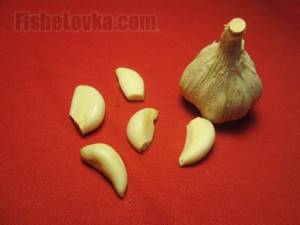
Photo 2. Garlic is one of the most popular attractants.
- Some medications have an effect similar to the above products - Corvalol, turpentine, camphor, Zvezdochka balm.
- Extracts from dung worms.
- Mixtures based on animal blood.
- Fishermen confirm the effect of kerosene in the same direction.

Photo 3. Corvalol has also been used in fishing for a long time.
These products have a different purpose than luring fish. Their effect has not been proven by scientists or research, but they have been used effectively in fishing for a long time. Traditional attractants are determined by the experience of our ancestors.
Pheromone-based lures
Modern scientific research in the field of fisheries began to use pheromones as bait almost two decades ago. The effectiveness of these products was proven and patented back in 2001. Their action is aimed at the natural receptors of fish.
It has long been known that these silent creatures communicate with each other by exchanging specific signals, which are sent using pheromones. Just as humans synthesize hormones, fish produce certain pheromones in different situations. Thanks to them, fish individuals gather in schools, reproduce, feed, and exist. It is worth noting that the olfactory abilities of these aquatic inhabitants are more developed than those of dogs.
Reference! Pheromones used for fishing are biologically active substances of synthetic origin, identical to natural pheromones that are secreted by fish.
Many years of studying the life activity of fish allowed scientists to artificially synthesize substances that attract their attention. But it happens that the interest of aquatic inhabitants alone is not enough. We've all had cases where fish walk around but don't bite. Thus, modern bait with pheromones is aimed at:
- to attract attention;
- stimulation of hunger;
- pack reflex.
Hunger-stimulating pheromones represent the most modern group. These artificially synthesized substances are identical to natural ones, which are produced in the body of hungry individuals. They help to increase the natural feeling of hunger in fish, prompting them to immediately search for any food. Thus, the fish does not easily swallow the bait; it actively searches for any type of food.
Attention! By using pheromones for fish, they achieve their attraction, promote a good bite due to hunger, as well as the accumulation of a large number of individuals at the fishing site, due to their gathering in schools.
Synthetic lures with pheromones
Bait with pheromones for fishing appeared as a result of expanding the understanding of the behavior of fish and the structure of its sensory organs. During the development, scientists from various scientific fields were involved, and according to numerous fishermen, the result is worth it.
Synthesized pheromones for fishing do not just attract fish, because this is not enough for fishing success. All effective fishing methods involve not only attracting attention, but also increasing the fish’s activity in relation to the bait.
Fish baits with pheromones simultaneously have 3 key effects:
- lure fish to the feeding area;
- increase the feeling of hunger, even well-fed fish greedily grab the bait;
- provoke fish to form schools and force them to take schooling actions.
Advanced developments can induce a feeling of hunger in fish; this effect has not been achieved before. This action became possible thanks to the discovery of a method for the synthesis of substances produced in the body of hungry individuals. Synthetic ingredients are completely consistent with their natural counterparts. Having delivered the pheromone bait to the fishing site, the victim experiences an urgent need to look for food, this leads to an attack on the bait on the hook.
Hungry individuals of most fish species tend to flock together when they feel hungry. It is easier for a fisherman to get a good catch in one place; he often manages to get 10-20 medium or 3-7 large fish from one place with constant, continuous bites.

The composition of attractants is very diverse
Attractants with pheromones for different types of fish
Different populations of fish prefer certain foods and react more actively to odors that are special to them. This is due to the nature of the fish’s habitat, climatic conditions, reservoir, and natural food. The less related the fish species, the more different their tastes. Based on this, manufacturers create baits aimed at attracting certain populations.
These baits consist of components that have a specific taste and smell that are of interest to a specific type of fish. More often these are elements of food with which she is already familiar. But with the inclusion of chemicals that have an effect on fish, for example, acids:
- glycine;
- dairy;
- glutamine and the like.
Propylene glycol substances also attract the attention of fish. The action of attractants is aimed not only at the taste preferences of fish, but also at instincts. Therefore, the effectiveness of baits using pheromones that attract the attention of specific fish is much higher. Thus, attractants have been developed for catching crucian carp, pike, catfish, pike perch, carp, bream and others. There are universal attractants for predatory or peaceful fish.
Predatory fish often obtain food, relying mainly on vision. Therefore, it is interested in bait and swallows soft baits (polymer, silicone) well, but due to inedibility, it often spits them out. This is where the possibility of impregnating soft bait with an attractant containing pheromones and other attractive components comes to the rescue.
General informationi
Women and men secrete special volatile substances called pheromones. They are responsible for attracting the opposite sex. The smell is always individual. At the dawn of humanity, this was what allowed people to distinguish each other.
The female pheromone is copulin. Its degree of release is individual. The person himself does not smell anything. The influence occurs on a subconscious level.
There is a theory that if a person of the opposite sex smells unpleasant (and this cannot be explained by sweat or other similar odor) and the woman feels disgusted by it, this indicates genetic incompatibility.
There are two groups of glands in the human body - sweat and sebaceous. Sweat cells are further divided into two groups: apocrine and eccrine. The first are located in the anus, genitals, armpits, nipples, and eyelids. They start working only in adolescence. Their ducts are located in the hair follicles and therefore there is debate among scientists about the functional role of hair.
Hair on the head protects from the sun, on the pubic area from friction and as a barrier against dirt. Armpit hair doesn't do any work. Therefore, it is believed that their task is to emit pheromones.
Eccrine sweat glands are located throughout the body. They produce sweat on the feet and palms.
The olfactory organs have a complex structure. It has a special section - the vomeronasal organ. Its receptors are located in the path of inhaled air. That is, a person will not disable its work in any way. This site was first discovered in early 1703.
The organ reacts not only to pheromones, but also to other volatile substances. Something that does not have a distinct odor.
Release form of pheromone baits
Bait using pheromones is widely produced by well-known manufacturers who are engaged in development and work closely with chemists, biologists, and ichthyologists. Small firms also produce bait, but their technology is more based on traditional food additives or animal blood extracts.
You can make such pheromones for fishing with your own hands. The most interesting components for fish, which are often on hand, are discussed above. All that remains is to study the information about the preferences of certain species for which the potential catch is designed. And then you just need to prepare the desired mixture.
Groundbait with pheromones is sold in various forms:
- gels;
- dry mixes;
- solutions;
- sprays.
It is worth choosing the form that is most convenient for a particular fishing.
Rules for using bait with pheromones
Depending on the form of release and the concentration of the active substance, bait is used in its pure form (spray, gel) or diluted in the amount of water or feed prescribed according to the instructions. For example, the well-known attractant Ultrabyte is available in 5 ml ampoules. According to the instructions, this concentrate should be diluted in 0.5 liters. water. To avoid overspending, you can take the required amount using a medical syringe, and then dissolve it in the appropriate volume of liquid. But it is recommended to seal the ampoule or seal it with fishing plasticine to preserve the properties of the active elements.
With pheromone concentrate you can:
- process bait and tackle;
- add to food;
- throw into water (some attractants are produced in special water-soluble polyethylene packages, ready to be completely immersed in water).
Manufacturers claim that pheromone baits are not always effective when used with other scented products. Such a complex of substances can attract fish, but with the same success it can scare them away.
Pheromone attractants are effective at any time of the year, regardless of whether the outside temperature is negative or positive. It is worth considering that the components quickly lose their activity in the open air, in less than half an hour. While in the aquatic environment they affect fish receptors for 7–9 hours. Attractants completely decompose in the aquatic environment within half a day, without having a negative impact on the reservoir or the life of fish.
The effect of pheromones on fish, truth or myth?
Today on the Internet there are a lot of different types of videos and advertising sites where they are trying to sell us so-called universal baits based on pheromones, from which the fish themselves cling to your fishing rod.
I categorically do not recommend buying this product, because there is no universal bait, just as there is no one cure for all diseases. And everything that is now being sold on the Internet is lies and deception. Therefore, I strongly advise against buying these pseudo baits on the Internet.
Where to buy pheromones?
Today, pheromones for bait are not sold in their pure form, because not even the largest company can recoup the sale of such products.
But this doesn't mean you should despair. After carefully studying information from various sources, I found two methods to solve this difficulty.
Method No. 1 Make artificial pheromones at home.
This method is more labor-intensive and requires more effort, but you can experiment with the ingredients. The essence of the method is to make a sweet syrup for herbivorous fish or blood, or a substitute for it for predatory fish, and add it to the main bait.
Plus, you can add a drop of anise, hemp or linseed oil to the bait to increase the aroma of the bait when the bite is low, but you should not overuse oil, syrup and blood, otherwise you will get the opposite deterrent effect.
Method No. 2 Buy artificial pheromones at a fishing store.
When you come to a fishing store, you must clearly decide what kind of fish you are going to catch: predatory or herbivorous? For predatory fish, the choice in the store is not very diverse, but even here you can look for the ingredients we need for bait. Blood balls are best suited for the main bait, chopped worms, maggots, and lemongrass.
For herbivorous fish, the choice is more varied. In addition to the main components, you can add essential oil with a fruit additive or cinnamon to the bait, but it is important to remember that in stagnant water the oil must be used very carefully so as not to cause burns to the fish.

A universal remedy, better than pheromones.
There are no universal pheromones for every type of fish for every occasion, this is true, but there is something better! This remedy has saved me more than once even on the worst day, but it only works on herbivorous fish. And the remedy is adding a few milligrams of insect poison.
It is only important that the composition does not contain pesticides, otherwise a fiasco is guaranteed! The correct selection of the product and a well-made calculation (approximately 1:15) will provide you with a stable bite throughout the entire fishing trip.
To summarize, I want to say that the ability to fish depends to a greater extent not on bait, tackle, equipment, a boat, a navigator and the like, but on one’s experience and knowledge of the fish’s habits.
Experience in fishing is purely a matter of gain, where quantity turns into quality, and the habits of the fish must be studied directly on the reservoir where the fisherman catches fish, because its habits can vary. But in any case, with due diligence and desire, you can learn this and become a professional.
Happy fishing!
